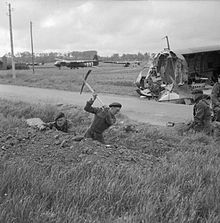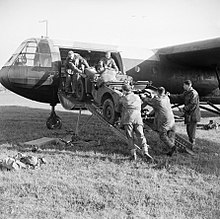Glider


Cargo gliders are military glider planes that are capable of transporting airborne troops with their equipment and armament, and in the case of larger models also trucks or tanks . They were used in World War II and replaced by the newly developed helicopters when it ended.
history
At the beginning of the 1930s, the first project studies and the construction of test models took place in the German Reich and in the Soviet Union . In the German Reich, the OBS small cargo sailing ship was built at DFS in Darmstadt for research purposes . Ernst Udet , who was flown in front of the OBS, then gave the instruction to develop a military glider, whereupon the DFS 230 was designed. The advantage of a cargo glider compared to a transport aircraft was that it could land a group of infantry at its destination and that no trained parachutists were necessary for the mission. A parachute jump always carried the risk that the jumpers could be driven off by the wind. Otherwise, towing a DFS 230 required a transport machine that could have transported the same number of paratroopers.
In 1934, the Groschew G-4 cargo glider designed for six soldiers was built in the Soviet Union . After the successful use of the DFS 230 in the conquest of Eben-Emael , both the Allies ( Hotspur , Great Britain) and the Axis powers ( Ku-1 , Japan and TM-2 , Italy) began to develop cargo gliders. The first model was also developed in the USA, which was still neutral at the time ( CG-3A ). Other countries such as Sweden ( Fi-3 ), Turkey ( THK-1 ), Australia and India followed suit, but did not achieve any significant results.
During the Second World War , gliders were repeatedly used. They were towed close to their targets by tow planes and then landed on or in the target area by the pilot . Most cargo gliders were deliberately built for single use and not salvaged or reused after use. In the course of the war, the constructed types became larger and larger, so that not only soldiers but also light military equipment could be transported. In the German Reich ( Me 323 ) and in the Soviet Union ( MP ) attempts were made to make cargo gliders capable of self-starting by installing engines and thus independent of tow planes. Unusual designs were the XLRA-1 (USA) and XLRQ-1 (Great Britain) models, designed as amphibious cargo gliders . A twin-hull experimental version of the "Hotspur" type ("Twin Hotspur") also existed.
German cargo gliders were later also used as transport aircraft, in particular to provide transport space when Air Force units were moved by air. Tow aircraft were then mostly the aircraft that were already in use, for example Junkers Ju 52 or Junkers Ju 87 . In the course of further development during the war, the Messerschmitt Me 323 "Gigant" large-capacity transport aircraft was developed from the large-capacity cargo gliders such as the Messerschmitt Me 321 "Gigant" .
The Western Allies used cargo gliders in large numbers in military operations. Cargo gliders were used to a much lesser extent by the Soviet Union. The remaining warring states did not use them at all or only to a very limited extent (Japan, Ku-8 ). After the Second World War, the role of cargo gliders was taken over by the helicopters capable of precision landings , so that gliders fell out of use. The Soviet Union and the ČSR used the Jak-14 and Z-25 types developed after the end of the war until the 1950s. The types created in France ( CM-1 ), the USA ( XG-14 , XG-18 and XG-20 ) and Yugoslavia ("Sostaric") remained experimental models.
In the remarkable Operation Beggar , 27 Horsa cargo ships were flown 5100 kilometers from England to Tunisia, with the No. 2 Wing, Halifax Glider Pilot Regiment of No. 295 Squadron of the Royal Air Force. From Tunisia they were used for the Allied landing on Sicily , which took place in stormy weather and was accordingly disastrous for the gliders.
Calls


The first combat deployment of gliders, the existence of which had been kept strictly secret up to this point, was the German attack on the Belgian fortress Eben-Emael on May 10, 1940. DFS 230 gliders were used.
The largest use of gliders on the German side took place in mid-May 1941 during the airborne battle over Crete . The Luftwaffe was able to use 80 to 100 gliders from Group I of Air Landing Squadron 1 for this purpose. Cargo sailors also played a decisive role in the German liberation of the arrested Italian dictator Benito Mussolini in the so-called " Operation Oak ".
The German Messerschmitt Me 321 "Gigant" was developed for a German invasion of Great Britain (" Operation Sea Lion "), which became impossible due to the German defeat in the Battle of Britain .
The Allies used cargo gliders in large numbers, especially in the failed Operation Market Garden , in the landing in Normandy ( Operation Overlord ) and in the crossing of the Rhine ( Operation Varsity ). US troops used the Waco CG-4A , the British the larger Airspeed Horsa and General Aircraft Hamilcar .
Two types of cargo gliders were also built in the Soviet Union, the Antonov A-7 and the Gribowski G-11 . They were mainly used to supply partisans in the German-occupied hinterland.
See also
literature
- Manfred Jurleit: The silent weapon. FliegerRevue 5–7 / 75
- Timothy Lynch: Silent skies. The glider was 1939–1945. Pen & Sword Military, Barnsley 2008, ISBN 1-84415-736-9 .
- James E. Mrazek: Silently into battle. The airborne war with cargo, combat and storm sailors. Motorbuch-Verlag, Stuttgart 1982, ISBN 3-87943-860-9 .
- Klaus Neetzow, Georg Schlaug: German cargo sailors 1938-1945. A chronicle in pictures. Verlag Grütter, Ronneburg 1993, ISBN 3-9801063-3-0 .
- Georg Schlaug: The German cargo sailing associations 1937–1945. A chronicle of reports, diaries, documents. Motorbuch-Verlag, Stuttgart 1985, ISBN 3-613-01065-8 .
- Alan Wood: History of the world's glider forces. Stephens Publishing House, Wellingborough / Northamptonshire 1990, ISBN 1-85260-275-9 .
